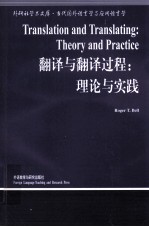
- 作 者:(英)贝尔(Bell R.T.)著
- 出 版 社:北京:外语教学与研究出版社
- 出版年份:2012
- ISBN:7560085296
- 标注页数:307 页
- PDF页数:345 页
请阅读订购服务说明与试读!
订购服务说明
1、本站所有的书默认都是PDF格式,该格式图书只能阅读和打印,不能再次编辑。
2、除分上下册或者多册的情况下,一般PDF页数一定要大于标注页数才建议下单购买。【本资源345 ≥307页】
图书下载及付费说明
1、所有的电子图书为PDF格式,支持电脑、手机、平板等各类电子设备阅读;可以任意拷贝文件到不同的阅读设备里进行阅读。
2、电子图书在提交订单后一般半小时内处理完成,最晚48小时内处理完成。(非工作日购买会延迟)
3、所有的电子图书都是原书直接扫描方式制作而成。
Part 1:MODEL 1
CHAPTER 1 Perspectives on translation 3
1.1 What is translation? 4
1.1.1 Equivalence:semantic and stylistic 6
1.1.2 Rules:description and prescription 10
1.1.3 Translation;process and product 12
1.1.4 Summary 14
1.2 What is a translator? 14
1.2.1 Memory,meaning and language 15
1.2.2 The communication process 17
1.2.3 The translation process 20
1.2.4 Summary 21
1.3 What is translation theory? 21
1.3.1 Theories,models and analogies 23
1.3.2 Requirements for a theory of translation 26
1.3.3 Methodology;investigating translation 28
1.3.4 Summary 31
1.4 Conclusion 32
CHAPTER 2 Translating;modelling the process 35
2.1 The translator:knowledge and skills 35
2.1.1 Ideal bilingual competence 38
2.1.2 Expertise 39
2.1.3 Communicative competence 41
2.1.4 Summary 42
2.2 Translating:the model 43
2.2.1 Components and processes 44
2.2.2 Analysis 45
2.2.3 Synthesis 58
2.2.4 Summary 60
2.3 Using the process to translate 60
2.3.1 Analysis:reading the source language text 62
2.3.2 Preparing to translate 68
2.3.3 Synthesis;writing the target language text 71
2.3.4 Summary 75
2.4 Conclusion 75
Part 2:MEANING 79
CHAPTER 3 Word- and sentence-meaning 83
3.1 Word-meaning:three approaches 84
3.1.1 Reference theory 84
3.1.2 Componential analysis 87
3.1.3 Meaning postulates 91
3.1.4 Summary 94
3.2 The thesaurus 95
3.2.1 Lexical and semantic fields 97
3.2.2 Denotation and connotation 98
3.2.3 Semantic differential 100
3.2.4 Summary 102
3.3 Sentence-meaning 103
3.3.1 Words and sentences 103
3.3.2 Utterance,sentence and proposition 106
3.3.3 Situation,context and universe of discourse 110
3.3.4 Summary 114
3.4 Conclusion 114
CHAPTER 4 Logic,grammar and rhetoric 117
4.1 Cognitive meaning,ideational function and TRANSITIVITY 123
4.1.1 Participants and processes 123
4.1.2 Circumstances 127
4.1.3 Logic and the translator 129
4.1.4 Summary 133
4.2 Interactional meaning,interpersonal function and MOOD 134
4.2.1 Communicative exchanges and clause options 137
4.2.2 Chain and choice:phrase options 141
4.2.3 Grammar and the translator 145
4.2.4 Summary 147
4.3 Discoursal meaning,the textual function and the THEME system 148
4.3.1 Organizing information;text structure 149
4.3.2 Thematization 150
4.3.3 Linking clauses:textual cohesion 154
4.3.4 Rhetoric and the translator 156
4.3.5 Summary 158
4.4 Conclusion 158
CHAPTER 5 Text and discourse 161
5.1 Standards of textuality 163
5.1.1 Cohesion and coherence 164
5.1.2 Intentionality and acceptability 167
5.1.3 Informativity,relevance and intertextuality 167
5.1.4 Summary 171
5.2 Speech acts and the co-operative principle 172
5.2.1 Components and rules 174
5.2.2 Indirect speech acts 178
5.2.3 The co-operative principle 181
5.2.4 Summary 183
5.3 Discourse parameters 184
5.3.1 Tenor 186
5.3.2 Mode 188
5.3.3 Domain 190
5.3.4 Summary 195
5.4 Conclusion 196
Part 3:MEMORY 199
CHAPTER 6 Text processing 201
6.1 Text-typologies 202
6.1.1 Formal typologies 203
6.1.2 Functional typologies 203
6.1.3 Text-types,forms and samples 204
6.1.4 Summary 206
6.2 Text processing:knowledge 206
6.2.1 Syntactic knowledge 207
6.2.2 Semantic knowledge 208
6.2.3 Pragmatic knowledge 209
6.2.4 Summary 211
6.3 Text processing:skills 211
6.3.1 Problem-solving and text-processing 214
6.3.2 Synthesis:writing 219
6.3.3 Analysis:reading 222
6.3.4 Summary 226
6.4 Conclusion 226
CHAPTER 7 Information,knowledge and memory 229
7.1 Human information-processing 230
7.1.1 Three stages 231
7.1.2 Three processes 234
7.1.3 Five demons 235
7.1.4 Summary 239
7.2 Knowledge 240
7.2.1 Conceptual categories and entries 241
7.2.2 Encyclopedic entries 245
7.2.3 Schemas 248
7.2.4 Summary 254
7.3 Memory systems 254
7.3.1 Episodic and conceptual memory 255
7.3.2 Addressing systems 256
7.3.3 Recall from memory 258
7.3.4 Summary 263
7.4 Conclusion 263
CHAPTER 8 Envoi 267
Appendix 269
Bibliography 275
Index 286
文库索引 299
